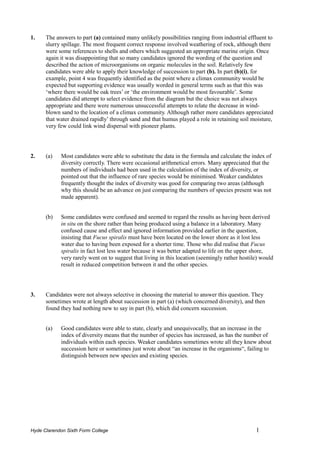Succession assessment reports
This document contains summaries of exam responses on topics related to ecology and succession: 1) Many candidates incorrectly described industrial effluent or slurry spillage instead of the provided explanation of weathered rock for shoreline deposits. Few could apply knowledge of succession to explain climax communities. 2) Most calculated diversity indices correctly but responses varied in interpreting the results. Better responses recognized adaptations allowing Fucus spiralis to outcompete others in its habitat. 3) Some wrote too much about succession where not required, failing to distinguish key points about changes in species numbers and individuals. Most described pioneer species roles but some unnecessary detailed climax communities. 4) Many misinterpreted the provided graph and did

Recommended
Recommended
More Related Content
What's hot
What's hot (13)
Viewers also liked
Viewers also liked (15)
Similar to Succession assessment reports
Similar to Succession assessment reports (12)
More from tanslides
More from tanslides (9)
Succession assessment reports
- 1. 1. The answers to part (a) contained many unlikely possibilities ranging from industrial effluent to slurry spillage. The most frequent correct response involved weathering of rock, although there were some references to shells and others which suggested an appropriate marine origin. Once again it was disappointing that so many candidates ignored the wording of the question and described the action of microorganisms on organic molecules in the soil. Relatively few candidates were able to apply their knowledge of succession to part (b). In part (b)(i), for example, point 4 was frequently identified as the point where a climax community would be expected but supporting evidence was usually worded in general terms such as that this was ‘where there would be oak trees’ or ‘the environment would be most favourable’. Some candidates did attempt to select evidence from the diagram but the choice was not always appropriate and there were numerous unsuccessful attempts to relate the decrease in wind- blown sand to the location of a climax community. Although rather more candidates appreciated that water drained rapidly’ through sand and that humus played a role in retaining soil moisture, very few could link wind dispersal with pioneer plants. 2. (a) Most candidates were able to substitute the data in the formula and calculate the index of diversity correctly. There were occasional arithmetical errors. Many appreciated that the numbers of individuals had been used in the calculation of the index of diversity, or pointed out that the influence of rare species would be minimised. Weaker candidates frequently thought the index of diversity was good for comparing two areas (although why this should be an advance on just comparing the numbers of species present was not made apparent). (b) Some candidates were confused and seemed to regard the results as having been derived in situ on the shore rather than being produced using a balance in a laboratory. Many confused cause and effect and ignored information provided earlier in the question, insisting that Fucus spiralis must have been located on the lower shore as it lost less water due to having been exposed for a shorter time. Those who did realise that Fucus spiralis in fact lost less water because it was better adapted to life on the upper shore, very rarely went on to suggest that living in this location (seemingly rather hostile) would result in reduced competition between it and the other species. 3. Candidates were not always selective in choosing the material to answer this question. They sometimes wrote at length about succession in part (a) (which concerned diversity), and then found they had nothing new to say in part (b), which did concern succession. (a) Good candidates were able to state, clearly and unequivocally, that an increase in the index of diversity means that the number of species has increased, as has the number of individuals within each species. Weaker candidates sometimes wrote all they knew about succession here or sometimes just wrote about “an increase in the organisms“, failing to distinguish between new species and existing species. Hyde Clarendon Sixth Form College 1
- 2. (b) Most candidates were able to describe the role of pioneer species in colonising a harsh environment and the ways in which they might change this environment. Better candidates then went on to say that these changes allowed new species to become established with the creation of new habitats for still other species. However, too many could not resist following the development right through to the climax and describing the nature of this condition. Clearly, given the question, this was not necessary and could have wasted valuable time for some candidates. 4. This question was directly related to the section on succession and required candidates to interpret data relating to a specific situation. Many responses reflected poor examination technique with candidates persistently failing to follow the instructions given and make use of the graph. (a) Candidates should be encouraged to take time to understand data given in the form of graphs or tables before attempting the questions. It appeared to the examiners that many considered the figure to represent data that they had previously encountered, and interpreted it as representing changes in population with time. Better candidates were, however, able to recognise that Species X had a higher rate of photosynthesis at higher light intensities and some were able to link this to competition and establishment at an early stage in succession. (b) Those candidates who had interpreted the graph successfully were usually able to point out that species X would produce shade and under these conditions species Z, with its higher rate of photosynthesis at lower light intensities, would be able to grow. There were many answers, however, based on Species X growing, dying and adding nutrients to the soil. Such an answer may have been partly correct but it made no use of the data provided, an essential prerequisite to gaining credit. Hyde Clarendon Sixth Form College 2